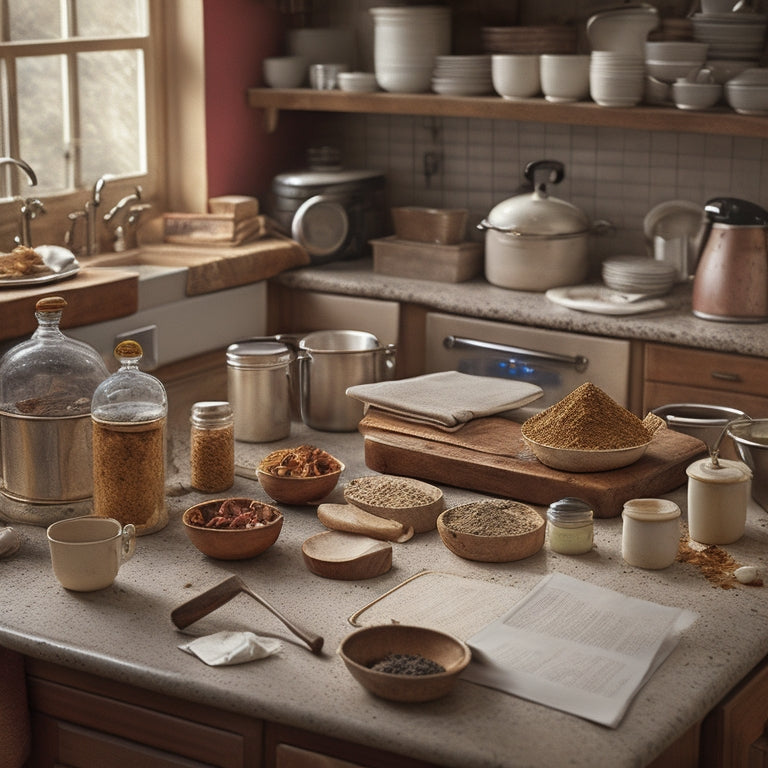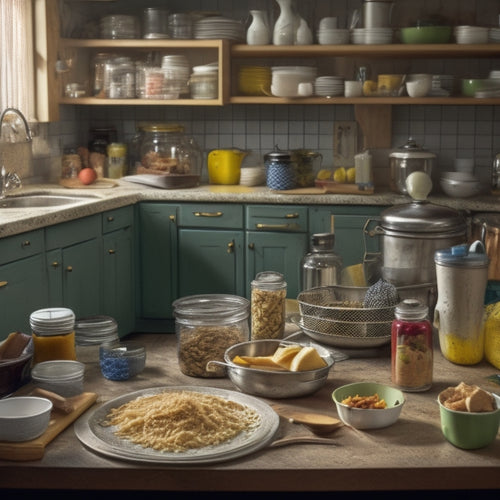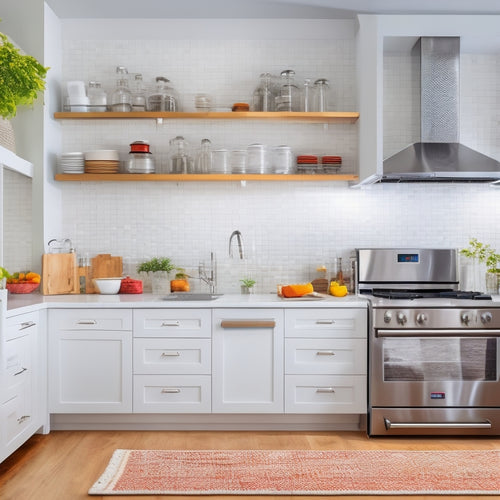
What's Holding You Back From a Clutter-Free Kitchen?
Share
You're likely holding onto clutter in your kitchen because of a combination of outdated habits, emotional attachments, and inefficient systems that are preventing you from creating a peaceful and organized cooking space. You might be cluttering your countertops with unnecessary appliances, holding onto sentimental items like grandma's utensils, or simply not knowing where to start with organizing your utensils and tools. By reassessing your kitchen's workflow and priorities, you can break free from these clutter culprits and create a space that sparks joy and efficiency - and the next steps to get you there are just ahead.
Key Takeaways
• Appliance manuals and recipe books taking over countertops and shelves prevent a clutter-free kitchen.
• Outdated or trendy gadgets collecting dust and occupying valuable space hinder kitchen organization.
• Insufficient utensil organization and storage lead to cluttered drawers and countertops.
• Failure to reassess food placement and prioritize counter space results in a disorganized kitchen.
• Emotional attachment to sentimental items, such as grandma's utensils, prevents decluttering and organizing.
Countertop Clutter Culprits Exposed
Take a closer look at your countertops and you'll likely find a slew of clutter culprits, from appliance manuals and recipe books to coffee makers and toaster ovens, vying for precious space. You're not alone in this struggle, but it's time to take control.
The key to a clutter-free kitchen is Surface Prioritization. Ask yourself, what do you use daily, and what can be stored away? Be honest, do you really need that coffee maker taking up prime real estate?
Reassess your Food Placement to optimize your counter space. Designate zones for food prep, cooking, and storage. Consider a utensil organizer or a spice rack to keep essentials within reach. By doing so, you'll create a more efficient and peaceful cooking environment.
The Utensil Drawer Dilemma
Establishing Drawer Divisions is crucial for organizing your utensil drawer filled with a jumbled mix of serving spoons, spatulas, and whisks. Separate your utensils into categories, such as baking, cooking, and serving, to create a sense of order. This simple step will help you locate the tools you need quickly and efficiently.
Next, determine your Utensil Priorities. Identify the items you use most frequently and store them in easy-to-reach locations. This will save you time and energy in the long run. Consider storing less frequently used items in a secondary location, such as a separate drawer or container.
Outdated Gadgets Taking Space
Now that you've optimized your utensil drawer, it's time to tackle the gadgets that are hogging space on your countertops and in your cabinets. Be honest, how many of those gadgets do you actually use regularly? Take a closer look at the ones that are collecting dust and consider letting them go. You know, the ones that were trendy a few years ago but now just take up valuable real estate in your kitchen.
It's time to create a gadget graveyard – a designated spot where you can temporarily store gadgets you're unsure about keeping or letting go of. This will help you determine what's truly essential to your cooking routine. By doing so, you'll be able to identify the space hogs that are holding you back from a clutter-free kitchen.
Kitchen Tool Organization Hacks
About 80% of your kitchen tools are likely used regularly, but they're probably scattered all over the place, making meal prep a frustrating ordeal. It's time to take control of the chaos and create a system that works for you.
Here are some kitchen tool organization hacks to get you started:
-
Designate a Tool Station: Assign a specific area, like a cart or a drawer, as your go-to spot for frequently used tools.
-
Implement Zone Design: Divide your kitchen into zones, such as baking, cooking, and prep, and store tools accordingly.
-
Utilize Vertical Space: Maximize your walls by installing hooks, racks, or a pegboard to hang tools, freeing up counter space.
-
Label and Categorize: Organize tools by type (e.g., all utensils together) and label each category for easy identification.
-
Store Less-Frequently Used Tools: Keep infrequently used tools, like special occasion gadgets, in a separate area or storage container to declutter your main workspace.
Streamlining Your Appliance Lineup
Take stock of your appliance collection and ask yourself: are there devices collecting dust on your countertops or hidden away in cabinets, serving no purpose but to clutter your kitchen? It's time to prioritize and streamline your appliance lineup.
Start by identifying your luxury essentials – the appliances you use daily or can't live without. These might include a high-quality coffee maker, a stand mixer, or a slow cooker. Be honest with yourself; if you haven't used it in the past year, it's probably safe to let it go. Consider donating or selling items that are still in good condition.
Next, categorize your remaining appliances into must-haves, nice-to-haves, and occasional-use items. This will help you determine which appliances deserve prime real estate on your countertops and which can be stored away. Implement an 'out of sight, out of mind' approach for less frequently used items, and consider investing in multi-functional appliances to reduce clutter.
Hidden Storage Opportunities
You'll be surprised at the hidden storage opportunities waiting to be uncovered in your kitchen, from the space beneath your cabinets to the interior of your kitchen island. These often-overlooked areas can hold a wealth of kitchen essentials, freeing up valuable counter and shelf space.
Here are some hidden storage opportunities to explore:
-
Kitchen Nooks: Utilize the space between your wall and countertop for a slide-out spice rack or a narrow shelf for cookbooks.
-
Backsplash Shelves: Install a shelf or ledge behind your cooktop or sink to store oils, spices, or frequently used utensils.
-
Cabinet toe-kick drawers: Add a slide-out drawer to the base of your cabinets to store cleaning supplies or infrequently used items.
-
Island storage: Optimize the interior of your kitchen island with shelves, drawers, or a Lazy Susan to keep items within easy reach.
-
Ceiling-mounted storage: Suspend a pot rack or a utensil holder from the ceiling to free up cabinet space and add visual interest.
Simplifying Kitchen Workflow Patterns
How can you streamline your kitchen workflow to reduce chaos and maximize efficiency? By optimizing your workflow, you'll be amazed at how much more you can accomplish in less time. Start by analyzing your daily kitchen tasks and identifying areas where you can simplify and segment tasks. This process is called Task Segmentation, and it's a game-changer for Workflow Optimization.
For instance, instead of trying to prep, cook, and clean simultaneously, break each task into smaller, manageable chunks. Set up a prep station, then move on to cooking, and finally, focus on cleaning. This approach will help you stay focused, reduce mistakes, and complete tasks more quickly.
Another strategy is to designate specific zones in your kitchen for specific tasks. For example, designate a zone for food prep, another for cooking, and another for cleaning. This will help you move efficiently between tasks and reduce clutter.
The Multipurpose Tool Myth
As you stand in your kitchen, surrounded by gadgets and gizmos, you might think having multiple tools that can do it all will make your life easier. But let's be real, you're probably finding it harder to focus on the task at hand with so many options cluttering your countertops.
It's time to debunk the myth that more is better and explore how tool overload, limited functionality, and single-task mastery can actually simplify your kitchen workflow.
Tool Overload Hinders Focus
Having too many tools at your disposal can actually hinder your ability to focus on the task at hand. You might think that having every gadget and gizmo will make you more efficient, but in reality, it can lead to decision fatigue. When you're faced with too many options, it's harder to prioritize tasks and make decisions. This can lead to procrastination and a sense of overwhelm.
Here are some signs that tool overload is holding you back:
-
You spend more time choosing which tool to use than actually using it.
-
Your countertops are cluttered with gadgets you rarely use.
-
You feel anxious or stressed when trying to decide which tool to use.
-
You're constantly switching between tools, wasting time and energy.
-
You've lost sight of your goals and priorities in the sea of options.
Limited Functionality Exposed
You've likely fallen prey to the multipurpose tool myth, believing that a single gadget can masterfully perform multiple tasks, but the truth is that most tools are designed to excel in one specific area. This misconception can lead to cluttered countertops and drawers, as you accumulate gadgets that promise to do it all but ultimately underdeliver.
The reality is that design constraints often limit a tool's functionality, making it a space waster in your kitchen.
Take, for instance, a veggie peeler that claims to also slice and dice. In practice, it might struggle to perform any of these tasks efficiently, leaving you frustrated and disappointed.
When you recognize the limited functionality of these gadgets, you can start to let go of the idea that one tool can do it all. By acknowledging the design constraints that hinder their performance, you can begin to declutter your kitchen and make room for tools that truly excel in their intended purpose.
It's time to break free from the myth and create a more streamlined, efficient kitchen that works for you, not against you.
Single Task Mastery
Your kitchen drawers and countertops can finally breathe a sigh of relief as you adopt the concept of single task mastery, where each tool is deliberately chosen to excel in one specific area, freeing you from the burden of clutter.
By embracing single task mastery, you'll realize that the 'do-it-all' tool is a myth. It's time to let go of the idea that one tool can expertly perform multiple tasks. Instead, focus on task segmentation and skill specialization. This means assigning one task to one tool, allowing each to shine in its designated area.
Here are the benefits you can expect:
-
Efficient storage: With a dedicated tool for each task, you'll need less storage space.
-
Improved functionality: Each tool will perform its designated task with precision and ease.
-
Reduced clutter: No more overcrowded drawers or countertops.
-
Increased productivity: With the right tool for the job, you'll work more efficiently.
-
A sense of liberation: You'll finally be free from the stress of cluttered kitchen spaces.
Overcoming Emotional Attachment
Let go of the guilt: it's crucial to acknowledge that those dusty cookbooks or your grandmother's old utensils are holding you back from achieving your clutter-free kitchen vision. You've been holding onto them due to sentimental value, but it's important to recognize that the memories attached to these items are what's truly important, not the items themselves.
| Item | Memory Triggers | New Solution |
|---|---|---|
| Grandma's utensils | Memories of baking together | Take a photo of the utensils and create a digital album or frame it as a reminder |
| Dusty cookbooks | Recipes from special occasions | Scan or digitize the recipes and let go of the physical books |
| Old mixing bowl | Family gatherings | Keep a small, sentimental item like a spoon or whisk, and let go of the rest |
Frequently Asked Questions
How Do I Declutter My Kitchen When I Live With Clutter-Loving Family Members?
"Living with clutter-loving family members can be tough. Identify Clutter Enablers and address Family Dynamics by setting boundaries, educating them on the benefits, and involving them in the decluttering process to create a shared vision for a more organized space."
Can I Still Achieve a Clutter-Free Kitchen in a Small or Rental Space?
You're maneuvering a small or rental kitchen like a captain charting uncharted waters. Don't worry, you can still achieve a clutter-free haven! Utilize Rental Hacks like multi-functional furniture and Space Savers like wall-mounted shelves to maximize every inch, and liberate your kitchen from clutter.
What if I Have Limited Time or Energy to Dedicate to Decluttering?
When you're short on time or energy, you create Time Blocks - 10-minute daily decluttering sessions - and utilize Energy Hacks, like tackling one area at a time, to make progress and reclaim your kitchen space.
How Do I Balance Functionality With Aesthetics in My Kitchen Design?
You balance functionality with aesthetics in your kitchen design by applying design principles like the "work triangle" and prioritizing space planning, ensuring a harmonious blend of form and function that sparks joy and efficiency.
Are There Any Eco-Friendly or Sustainable Decluttering Methods for My Kitchen?
"Break free from the chains of clutter, dear Renaissance soul! You're seeking eco-friendly decluttering methods, and rightly so. Opt for Zero Waste practices, scan for Eco Labels, and thoughtfully repurpose items to create a harmonious, sustainable kitchen sanctuary that nourishes both you and the planet."
Related Posts
-

What's Holding You Back From a Clutter-Free Kitchen?
You're struggling to achieve a clutter-free kitchen, and it's not because you're lazy or don't care. You're likely he...
-

Optimize Your Kitchen Storage With 7 Simple Hacks
You're already wasting valuable kitchen space without realizing it, and it's likely due to a lack of strategic storag...

